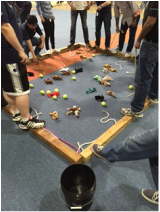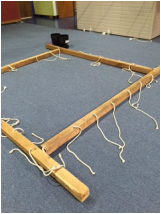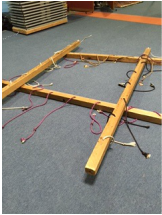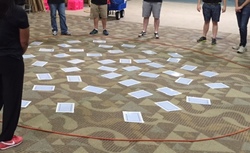Set Up: Set down four, 4-inch by 4-inch boards, 6 to 8 feet in length (Trolley’s with ropes work for this) into a large square configuration (see Photo 1). (If there are ropes on/in the boards be sure they are pulled out from underneath each board so the boards lay flat on the ground/floor – as long as the bottom of the Trolley boards are not facing up, it does not matter where the top of the boards are placed). Place a large number (50 to 75) small objects (golf balls, tennis balls, Beanie Babys, wads of paper, fleece balls) in the center area of the square – spread out the objects so that no object is any closer than two feet from any board. Place one or two large buckets near one of the corners of the square, on the outside of the square.
Objective: Move objects (for points) from within the square of boards into the bucket located outside the square without touching the floor/ground.
Time Limit: For a competitive activity with two or more teams, set a time limit of 8 to 12 minutes to collect objects with a few minutes up front for planning.
For a single group (16 to 24 people), play until all materials are collected – the group will need to reconfigure the square to retrieve objects (thinking “out of the box”). Variation: If you have an Expandable Cube, put all the parts into the center of the square - the group has to get all the parts in order to create the Cube element for the next challenge.
RULES of PLAY
- The materials related to the activity, including the objects to be retrieved, can only be touched if everyone in the group is standing on the boards – no feet touching the floor/ground – with the exception of the bucket(s). The bucket(s) may not be moved.
- Objects can only be picked up – may not be used in any other way – from the center of the square – the boards must be in a square (four equal sides) configuration for objects to be retrieved. In other words, these objects (including any ropes in the area) may not be used to retrieve any other objects.
- If a player touches the floor/ground at any time after the activity begins, any objects s/he is holding must be given to the facilitator (who will place them back into the center of the square). Also, if there are objects in the bucket one is taken out (by the facilitator) and placed back into the center after a touch of the floor/ground.
- When a player is able to retrieve one or more objects from the center of the square s/he must put them or toss them into the bucket in order to score points (e.g., one point for each object retrieved) – objects may not be passed/given to any other player after being picked up.
- When using Trolleys with ropes attached, players can use the ropes for support if the ropes are not touching the ground.
Facilitation Notes: Spot players when you can and encourage them to help each other during dynamic movements. If the group discovers and decides to move the boards in order to make a smaller "square" (getting closer to the objects), be sure to remind them to be careful of board-to-body contact and pinch points. There is one square configuration (Photo 3) where boards might be placed on top of other boards resulting in players being higher off the ground. Let the group know about the elevated risk potential and be sure to spot movements from these boards where and when you can.
A way to explain handling the materials in the activity is to say that the center of the square is "outer space" and the materials are floating within – weight cannot be put on the floor in any way. Your boards are a space ship that can contain the objects if the ship is in a square formation (equally distributing its particle beams within the cargo bay - or something of this nature).
Heads Up: Based on Rule 4, players will end up walking around on top of the boards. Be mindful of any spotting needs during this movement.
Let me know how this goes for you!! Leave a comment below.
Have Fun Out There!
Chris Cavert










 RSS Feed
RSS Feed